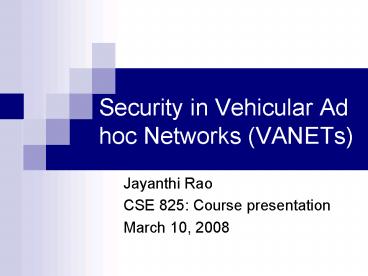Security in Vehicular Ad hoc Networks VANETs PowerPoint PPT Presentation
1 / 24
Title: Security in Vehicular Ad hoc Networks VANETs
1
Security in Vehicular Ad hoc Networks (VANETs)
- Jayanthi Rao
- CSE 825 Course presentation
- March 10, 2008
2
Acknowledgements
- Presentation based on
- Maxim Raya and Jean-Pierre Hubaux, The security
of vehicular ad hoc networks, SASN 2005. - Bryan Parno and Adrian Perrig, Challenges in
securing vehicular networks, SECON 2005. - Some slides courtesy above authors.
3
Presentation outline
- What is a VANET?
- VANET applications
- Adversaries
- Security threats and attacks
- Security primitives for attack prevention or
handling strategies
4
A modern vehicle
A modern vehicle is a network of
sensors/actuators on wheels !
5
What is a VANET (Vehicular Ad hoc NETwork)?
- Communication typically over the Dedicated
Short Range Communications (DSRC) (5.9 GHz) - Example of protocol IEEE 802.11p
6
Motivation for VANET
- Increase safety
- Hundreds of thousands of people are killed
world-wide due to road accidents yearly. - Many more are injured.
- Traffic optimization
- Congestion/traffic jams cost time and fuel.
Both these problems can be solved or mitigated
by giving timely information to the drivers!
7
Differences from MANET
- Large scale potentially billion
- Fleeting contact with other vehicles
- Nodes not as constrained in terms of energy,
storage and computation.
8
VANET applications
- Safety alerts
- Requirement Bounded latency
- Primary Issue Broadcast storm
- Congestion warning
- Requirement Message persistence
- Primary Issue Disconnected network
- Infotainment
- Requirement End-to-end connectivity
- Primary Issue Disconnection due to high mobility
9
Application-1 Congestion Detection
- Vehicles detect congestion when
- Vehicles gt Threshold 1
- Speed lt Threshold 2
- Relay congestion information
- Hop-by-hop message forwarding
- Other vehicles can choose alternate routes
10
Application-2 Deceleration Warning
- Prevent pile-ups when a vehicle decelerates
rapidly
11
Attackers
- Insider or outsider
- Insider valid user
- Outsider Intruder, limited attack options
- Malicious or rational
- Malicious No personal benefit, intends to harm
other users - Rational seeks personal benefits, more
predictable attack - Active or passive
- Active Generates packets, participates in the
network - Passive Eavesdrop, track users
12
Security Attacks
Goals
Execution
Actions
Congestion Creation/ avoidance
Insert bogus congestion warnings
Single
Single, multiple Entities (Sybil)
Misrepresent Location of accident
Cause accidents or pile-ups
Track individuals
Multiple
Message suppression
Aggressive insertion of messages/jamming
Denial of service
Independent
Colluding
13
Security Requirements
- Authentication
- React only to legitimate events. Authenticate
senders of messages. - Verification of data consistency
- Legitimate senders can send false data
(attack/unintentional). Can cause immense damage
even fatalities. - Availability
- Network should be available under jamming attacks
- Non-repudiation
- Drivers causing accidents should be reliably
identified - Privacy (conflicts with authentication)
- Privacy of drivers against unauthorized
observers. - Real-time constraints
- High speed means constraints on time
14
Security Architecture
15
Key Management
- Key distribution
- How will the key be distributed ?
- Key certification
- Who will certify the keys ?
- Key revocation
- When the key is compromised, what is the
revocation procedure ?
16
Tamper-proof device
- Each vehicle carries a tamper-proof device
- Contains the secrets of the vehicle itself
- Has its own battery
- Has its own clock (notably in order to be able to
sign timestamps) - Is in charge of all security operations
- Is accessible only by authorized personnel
Tamper-proof device
((( )))
Vehicle sensors (GPS, speed and acceleration,)
Transmissionsystem
On-boardCPU
17
Digital signatures
- Symmetric cryptography is not suitable messages
are standalone, large scale, non-repudiation
requirement - Hence each message should be signed with a DS
- Liability-related messages should be stored in
the EDR
18
VPKI (Vehicular PKI)
- Each vehicle carries in its Tamper-Proof Device
(TPD) - A unique and certified identity Electronic
License Plate (ELP) - A set of certified anonymous public/private key
pairs - Before a vehicle sends a safety message, it
signs it with its private key and includes the
CAs certificate. - Mutual authentication can be done without
involving a server - Authorities (national or regional) are
cross-certified
19
The CA hierarchy two options
1. Governmental Transportation Authorities
2. Manufacturers
Manuf. 1
Manuf. 2
Car B
Car A
Car B
Car A
- The governments control certification
- Long certificate chain
- Keys should be recertified on borders to ensure
mutual certification
- Vehicle manufacturers are trusted
- Only one certificate is needed
- Each car has to store the keys of all vehicle
manufacturers
20
Key revocation
- All cryptographic material of a vehicle is
compromised - CA sends revocation message to the TPD.
- A particular key is compromised
- CA sends revocation message to the TPD for each
revoked key. High overhead. - Short key certificate lifetimes. Large storage
required.
21
Security primitives
- Authenticated localization of message origin
- Option 1
- Beacons broadcast location with timestamp and
signature. Include this packet in all messages. - Requires infrastructure.
- Option 2 Use relative localization
22
Security primitives Contd.
- Anonymization service
- Attempt to balance authentication and privacy
- Option 1
- Key changing algorithm that adapts to vehicle
speed - A large set of keys needs to be stored in the
vehicle and periodically renewed (during regular
vehicle maintenance visits) - Option 2
- Drivers authenticate to a service with their
permanent Id and receive a temporary Id that
cannot be traced back to the driver. - Infrastructure required.
23
Security primitives Contd.
- Secure aggregation
- Vehicle count the number of vehicles it passes
and reports the sum. Receiving vehicle
authenticates the information and is able to
estimate the amount of traffic ahead.
24
Questions?

